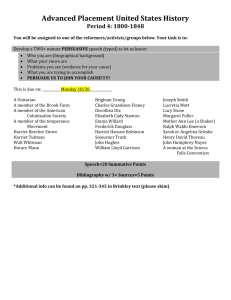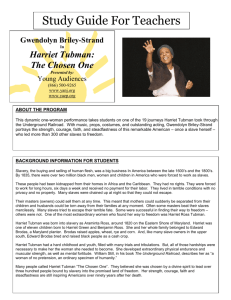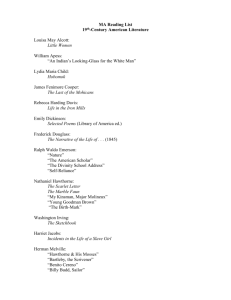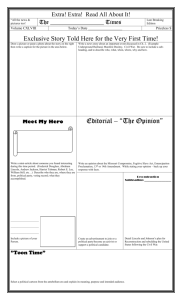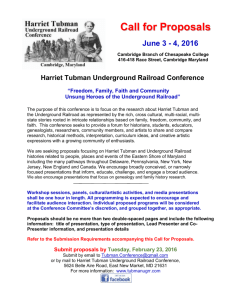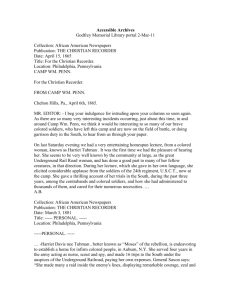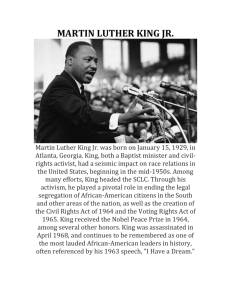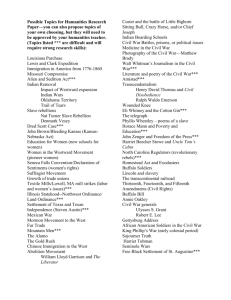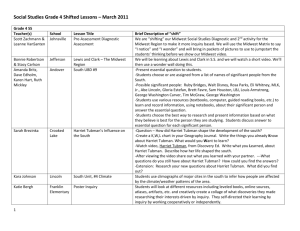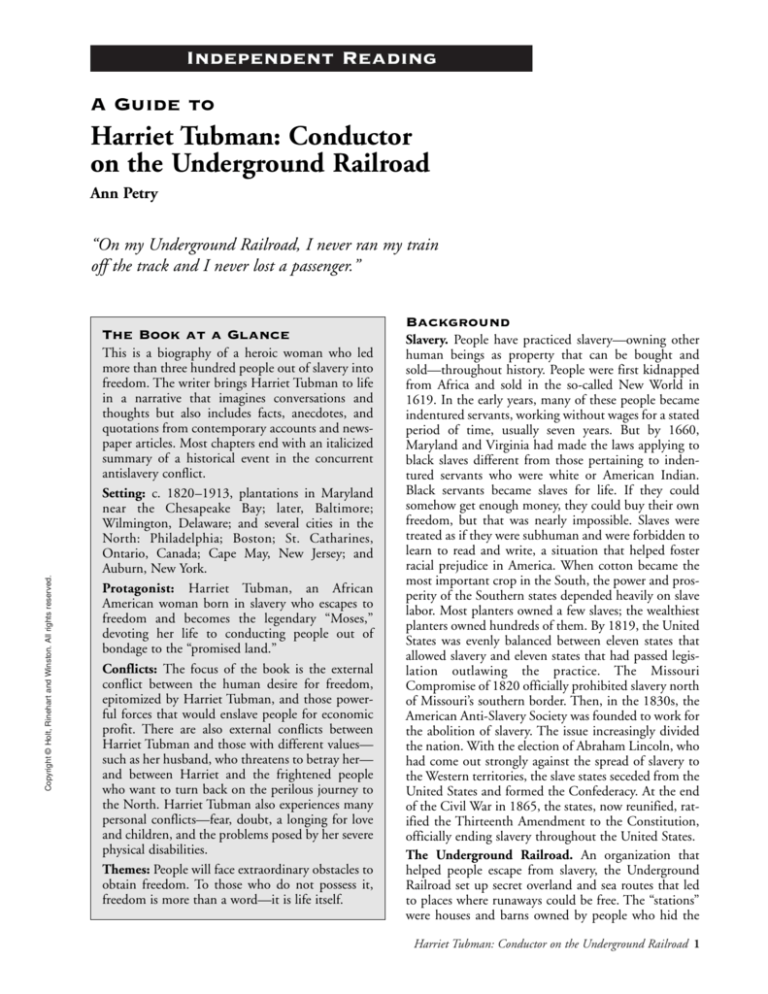
Independent Reading
A Guide to
Harriet Tubman: Conductor
on the Underground Railroad
Ann Petry
“On my Underground Railroad, I never ran my train
off the track and I never lost a passenger.”
Background
Copyright © Holt, Rinehart and Winston. All rights reserved.
The Book at a Glance
This is a biography of a heroic woman who led
more than three hundred people out of slavery into
freedom. The writer brings Harriet Tubman to life
in a narrative that imagines conversations and
thoughts but also includes facts, anecdotes, and
quotations from contemporary accounts and newspaper articles. Most chapters end with an italicized
summary of a historical event in the concurrent
antislavery conflict.
Setting: c. 1820–1913, plantations in Maryland
near the Chesapeake Bay; later, Baltimore;
Wilmington, Delaware; and several cities in the
North: Philadelphia; Boston; St. Catharines,
Ontario, Canada; Cape May, New Jersey; and
Auburn, New York.
Protagonist: Harriet Tubman, an African
American woman born in slavery who escapes to
freedom and becomes the legendary “Moses,”
devoting her life to conducting people out of
bondage to the “promised land.”
Conflicts: The focus of the book is the external
conflict between the human desire for freedom,
epitomized by Harriet Tubman, and those powerful forces that would enslave people for economic
profit. There are also external conflicts between
Harriet Tubman and those with different values—
such as her husband, who threatens to betray her—
and between Harriet and the frightened people
who want to turn back on the perilous journey to
the North. Harriet Tubman also experiences many
personal conflicts—fear, doubt, a longing for love
and children, and the problems posed by her severe
physical disabilities.
Themes: People will face extraordinary obstacles to
obtain freedom. To those who do not possess it,
freedom is more than a word—it is life itself.
Slavery. People have practiced slavery—owning other
human beings as property that can be bought and
sold—throughout history. People were first kidnapped
from Africa and sold in the so-called New World in
1619. In the early years, many of these people became
indentured servants, working without wages for a stated
period of time, usually seven years. But by 1660,
Maryland and Virginia had made the laws applying to
black slaves different from those pertaining to indentured servants who were white or American Indian.
Black servants became slaves for life. If they could
somehow get enough money, they could buy their own
freedom, but that was nearly impossible. Slaves were
treated as if they were subhuman and were forbidden to
learn to read and write, a situation that helped foster
racial prejudice in America. When cotton became the
most important crop in the South, the power and prosperity of the Southern states depended heavily on slave
labor. Most planters owned a few slaves; the wealthiest
planters owned hundreds of them. By 1819, the United
States was evenly balanced between eleven states that
allowed slavery and eleven states that had passed legislation outlawing the practice. The Missouri
Compromise of 1820 officially prohibited slavery north
of Missouri’s southern border. Then, in the 1830s, the
American Anti-Slavery Society was founded to work for
the abolition of slavery. The issue increasingly divided
the nation. With the election of Abraham Lincoln, who
had come out strongly against the spread of slavery to
the Western territories, the slave states seceded from the
United States and formed the Confederacy. At the end
of the Civil War in 1865, the states, now reunified, ratified the Thirteenth Amendment to the Constitution,
officially ending slavery throughout the United States.
The Underground Railroad. An organization that
helped people escape from slavery, the Underground
Railroad set up secret overland and sea routes that led
to places where runaways could be free. The “stations”
were houses and barns owned by people who hid the
Harriet Tubman: Conductor on the Underground Railroad 1
Major People in the Book
(in order of appearance)
Edward Brodas, the owner of the Maryland plantation
where Harriet Tubman was born.
Harriet Greene, also known as Old Rit, mother of
Harriet Tubman and ten other children. Born into
slavery, Old Rit was highly valued by Brodas and
worked in his house. She was a religious woman skilled
in folk medicine.
Benjamin Ross, father of Harriet Tubman; a trusted
worker with a reputation for honesty.
Harriet Ross Tubman, a woman of great personal
courage and physical strength. After escaping from slavery, she devoted her entire life to freeing others.
Mr. and Mrs. James Cook, farmers who couldn’t
afford to own slaves and so hired six-year-old Harriet to
work for them.
Miss Susan, a cruel, hot-tempered woman who hired
seven-year-old Harriet to clean her house and take care
of her baby; she beat Harriet unmercifully.
Doc Thompson, overseer who, after Edward Brodas’s
death, became the guardian of Brodas’s young heir and
manager of the Brodas plantation.
John Tubman, a free black man who married Harriet
in 1844; he refused to go north with her.
William Still, a black man who worked with the
Underground Railroad; served as secretary and recordkeeper of the Vigilance Committee in Philadelphia.
Thomas Garrett, a Quaker who hid fugitives in
Wilmington and helped transport them to the next
stop on the Underground Railroad.
Nelson Davis, second husband of Harriet Tubman;
because of his service in the Civil War, Tubman received
a small pension after his death.
Summary
Chapter 1. Tubman’s story begins in 1820 on the
Brodas plantation on the Tidewater, or Eastern Shore,
of Maryland. Brodas’s large house is contrasted with the
crude, one-room, windowless cabins in the plantation’s
slave quarter. The term manumission is introduced:
Many people held in slavery pinned their hopes on the
promise that if they were faithful and hardworking, the
master would manumit (free) them when he died. The
historical note at the chapter’s end mentions Thomas and
Sarah Garrett and John Brown.
2 Harriet Tubman: Conductor on the Underground Railroad
Chapter 2. Harriet’s early years are described as typical
of the way children held in slavery were raised. When
she was two years old, the adults began whispering
about new laws that further restricted their freedom of
movement. Denmark Vesey, a free African American
who planned a rebellion to free the slaves, had been
hanged. We learn that Brodas had promised to free Old
Rit and her children when he died, but Old Rit, like all
enslaved mothers, worried that her children would be
sold. The historical note is on Theodore Parker.
Chapter 3. Using historical details, the writer puts us
inside the mind of the six-year-old Harriet and helps us
understand, at least in a limited way, what slave life was
like on the Brodas plantation. Petry also begins to reveal
Harriet’s character traits, describing her as “slow of
speech, but quick to laugh.” The chapter ends on an
ominous note: The old woman who cares for the children in the Quarter warns little Harriet that soon the
overseer will “be settin’ you a task.” The historical note
points out that 1826 is the year Thomas Jefferson died.
Chapter 4. When she was only six years old, Harriet
was hired out to Mrs. Cook, a weaver married to a poor
trapper. Harriet inspected trap lines, a job that, in
metaphor, foreshadowed her adult mission: She hated
to see the muskrats caught in traps. However, the little
girl became very ill with measles and bronchitis and was
sent back to her mother. The bronchitis caused her
voice to be husky for the rest of her life. When she was
returned to the Cooks, the child, who loved the outdoors, had to stay indoors and weave. Mrs. Cook finally
sent her home, saying she was unteachable. The historical note focuses on the ambiguous situation of runaway
slaves who had fled to Canada.
Chapter 5. At the age of seven, Harriet was hired out
as a child’s nurse by Miss Susan, the child’s mother. An
abusive and ill-tempered woman, she whipped Harriet.
But Harriet learned a skill that later served her well: to
sleep while still being able to hear sounds. Whipped so
often that she carried horrible scars on her back all her
life, the seven-year-old finally ran away and hid in a pigpen until she was so starved she returned to her mistress.
Historical note: Henry Clay is told by the Canadian government that it cannot agree to surrender fugitive slaves.
Chapter 6. Returned again to the Brodas plantation
like an unsatisfactory purchase, Harriet was next hired
out to someone who had her do fieldwork, like a man.
Although a backbreaking job, it proved more to
Harriet’s liking than housework. During this time,
Harriet heard her first story of a slave who escaped “on
an underground road.” She also heard about Nat
Turner, a slave executed for leading a bloody rebellion
in Virginia. Fearful of insurrections, the owners made
conditions more difficult for the slaves; blacks were
now forbidden to learn to read and write, or even to
congregate in church services. Historical note: In 1831,
the Virginia Assembly, alarmed at Turner’s rebellion, petitioned for emancipation.
Copyright © Holt, Rinehart and Winston. All rights reserved.
fugitives and helped them to the next place at which
they could find aid. The “conductors,” brave men and
women like Harriet Tubman, guided runaways from
one safe station to the next. At first, runaways were considered free when they crossed over into a free state in
the North. But increasingly strict fugitive slave laws
later made it illegal for anyone, even in a free state, to
help runaways escape. To gain freedom, people had to
cross the border into Mexico or Canada.
Copyright © Holt, Rinehart and Winston. All rights reserved.
Chapter 7. As Harriet was helping a slave escape, the
overseer threw a weight at the fleeing man, which hit
Harriet on the head. Old Rit, who had already lost two
of her girls, sold South as part of the chain gangs, nursed
her daughter back to health. Although Harriet recovered, the blow left her subject to violent headaches and
profound sleeping seizures. Brodas tried to sell Harriet,
but no one would buy a woman who was so “damaged.”
Then suddenly the old master died. The historical note is
on William Lloyd Garrison, the famous abolitionist.
Chapter 8. Because Brodas’s heir was too young, Doc
Thompson managed the plantation for him. Harriet
was hired out to work for John Stewart, who enjoyed
exhibiting Harriet’s strength to his guests, a cruelty that
made the young woman feel like an animal trained for
spectators’ amusement. Harriet’s father now taught her
how to find her way through the woods without making a sound—as if to prepare his daughter for the day
she would have to escape. Historical note: A mob tries to
lynch Garrison in Boston.
Chapter 9. Harriet painstakingly made a patchwork
quilt for her wedding to John Tubman, a man who had
always been free. She found out that, according to the
will of her former mistress, Old Rit should have been
set free long before Harriet’s birth. Realizing that she
herself would have been born free if her mother had not
been tricked, Harriet dreamed of running away.
However, her husband told her he would betray her to
the master if she tried to escape. The historical note is on
Thomas Garrett, who was found guilty of sheltering runaway slaves and was financially ruined by punitive fines.
Garrett, however, refused to give up his work on the
Underground Railroad.
Chapter 10. When Brodas’s heir died, his slaves began
to be sold off. Desperate for freedom but knowing that
she might suddenly fall victim to a sleep seizure on the
road, Harriet was afraid to escape alone. So she persuaded three of her brothers to accompany her; but her
brothers changed their minds and forced her to return
with them. Discovering then that she had been sold,
Harriet knew that she must go north alone. Taking her
quilt, the symbol of her hopes for marriage and love,
she visited a white woman who had once offered her
help. From this woman, Tubman learned about the
Underground Railroad. She gave her cherished quilt to
the woman and traveled ninety miles into the free state
of Pennsylvania. There she felt she had landed in
heaven. Historical note: The argument about fugitive
slaves escalates in Congress.
Chapter 11. In Pennsylvania Harriet did housework to
earn money. She met William Still, a black officer of a
group that helped slaves escape. When she heard that
her sister Mary was about to be sold, she went to
Baltimore. After helping Mary and her children escape,
she guided them to freedom on the Underground
Railroad. Back in Philadelphia, Harriet heard of a
new Fugitive Slave Law, which severely punished both
runaway slaves and the people who helped them.
Historical note: The passage of the Fugitive Slave Law
widens the gap between North and South. Northerners
claim that the law obliges them to become slave catchers.
Chapter 12. Disguised as a man, Harriet Tubman
returned to Maryland to try to persuade her husband to
go north with her. Sadly, she found he had remarried.
Historical note: Theodore Parker writes a letter to the president, saying he will defy the Fugitive Slave Law.
Chapter 13. Because of the Fugitive Slave Law, Tubman
had to take her bands of fugitives all the way to Canada.
Soon she became a legend to the people held in slavery,
and they began to call her Moses. Historical note: A
group of abolitionists rescue a fugitive slave named Jerry
and are charged with treason.
Chapters 14 and 15. The plantation owners believed
that Moses was a man and offered rewards for his capture. Moses would announce her secret arrival in a slave
quarter by singing the forbidden spiritual “Go Down,
Moses.” On her first trip to Canada in December 1851,
Tubman led eleven people out of slavery. When she and
her party passed through Philadelphia, William Still
wrote down their names and the conditions of their
slavery, a record that he later included in a book.
Tubman’s group also stayed in Rochester, New York,
with Frederick Douglass, who described such a visit in
his autobiography. After a month’s journey, the group
crossed the border into Canada. Now Tubman’s life
took on a pattern: She spent the winter in St.
Catharines in Canada, and spring and summer in Cape
May, New Jersey, or Philadelphia, making two trips a
year into slave territory. Historical note: Harriet Beecher
Stowe’s powerful antislavery novel Uncle Tom’s Cabin
causes a sensation.
Chapter 16. In 1854, Harriet returned to Maryland to
rescue three of her brothers. Historical note: The forcible
return of fugitive slave Anthony Burns causes a furor in
Boston. The South now holds three million people in slavery. Their estimated market value is one billion dollars.
Chapter 17. Around Christmas, Harriet, her three
brothers, and three other slaves hid near the cabin
where Ben and Old Rit lived. Harriet sent two of the
fugitives to the cabin to tell Ben they were nearby and
needed food. Without looking at his children, so he
could truthfully say he had not seen them, Ben brought
them a Christmas dinner. Harriet promised Ben that
she would return to get him and her mother. She conducted the six runaways to Canada. Historical note:
John Brown arrives in Kansas, 1855.
Chapter 18. Harriet continued to bring slaves out from
Maryland. From 1851 to 1857, eleven trips are noted
in letters and record books. This chapter describes one
particularly dangerous escape in which Tubman led her
group across an icy river and hid them in a wagon
under a load of bricks. Historical note: John Brown murders five proslavery settlers in Kansas.
Harriet Tubman: Conductor on the Underground Railroad 3
Approaches for
Post-Reading Activities
Petry’s biography would serve as an excellent adjunct to
American history classes focusing on the 18th and 19th
centuries, particularly on the practice of slavery and the
divisions caused by that issue in the United States. The
natural follow-up to the biography is a research assignment, done either individually or in groups. Research
could culminate in one of the following assignments: a
written paper; an oral presentation with visuals, including a map of the Underground Railroad; a debate on
issues raised in the book; or a bibliography of other
materials (texts and art) dealing with issues raised in the
book. The topics listed below are mostly taken from the
brief historical notes that Petry uses to conclude most
chapters.
Copyright © by Holt, Rinehart and Winston, Inc.
All rights reserved. No part of this publication may be reproduced
or transmitted in any form or by any means, electronic
or mechanical, including photocopy, recording, or any information
storage and retrieval system.
Printed in the United States of America
4 Harriet Tubman: Conductor on the Underground Railroad
• John Brown and the raid on Harpers Ferry
• The role taken by the Quakers in the abolitionist
movement
• The Fugitive Slave Law
• Nat Turner’s insurrection
• William Lloyd Garrison
• Thomas Garrett’s Underground Railroad Station in
Wilmington, Delaware
• Harriet Beecher Stowe and her novel Uncle Tom’s
Cabin
• The case of Anthony Burns and the Fugitive Slave
Law
• Abraham Lincoln on slavery
• The use of spirituals as code songs
• The Dred Scott case
• Slave narratives
• Frederick Douglass
Meet the Writer
Ann Petry (1911–1997) was born in Old Saybrook,
Connecticut, and has lived there for most of her life.
She graduated from the College of Pharmacy at the
University of Connecticut and was a pharmacist, as her
father had been before her, for several years. After she
married, she moved to New York City and wrote for
newspapers and advertising agencies before she began
writing short stories and novels. Her best-known works
for young people are Harriet Tubman: Conductor on the
Underground Railroad and Tituba of Salem Village.
Read On
Virginia Hamilton, Many Thousand Gone. Stories of
enslaved Africans who journeyed to freedom; based on
historical documents and true accounts.
Jacob Lawrence, Harriet and the Promised Land. A
picture book featuring paintings by the great African
American artist; created as a tribute to Harriet Tubman
and her work.
Abraham Lincoln, “The Gettysburg Address.” The
speech delivered on November 19, 1863, in the midst
of the Civil War.
Martin Luther King, Jr., “I Have a Dream.” The
momentous speech delivered at the Lincoln Memorial
on August 28, 1963.
John Lewis, From Camelot to Kent State: The Sixties
Experience in the Words of Those Who Lived It. An
oral history of the civil rights movement.
Copyright © Holt, Rinehart and Winston. All rights reserved.
Chapter 19. When she returned to Maryland to bring
out her elderly parents, Harriet disguised herself so well
that Doc Thompson failed to recognize her. She took
her parents in a wagon to Wilmington, Delaware, and
later they finally entered Canada. When she realized
that the cold weather was too hard on them, Harriet
bought a house for them in New York. In 1858, she
met the fiery abolitionist John Brown, who said he was
about to free the slaves and needed her help to lead the
fugitives to Canada. Historical note: Dred Scott, a fugitive slave, is returned forcibly to his “owner.”
Chapter 20. By this time, 1859, Tubman was
renowned as a public speaker. John Brown’s aborted
seizure of the arsenal at Harpers Ferry resulted in his
execution. Historical note: John Brown is hanged on
December 2, 1859.
Chapter 21. During the Civil War Tubman served,
without pay, as a scout, spy, and nurse. In 1863, she
guided Colonel James Montgomery and his detachment of ex-slaves in a daring raid that rescued eight
hundred people from slavery. Historical note: Lincoln
says in a speech that the cash value of slaves would affect
the North just as it would the South.
Chapter 22. Tubman spoke in the cause of women’s
suffrage and raised money for schools for former slaves,
even though she had barely enough money to support
herself. After marrying a Civil War veteran who was
already ill with tuberculosis, she founded a home in
Auburn, New York, to care for him and for others in
need. Still destitute as an old woman, the great deliverer
of her people was peddling vegetables in Auburn.

